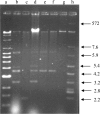Incidence and transferability of antibiotic resistance in the enteric bacteria isolated from hospital wastewater
- PMID: 24516448
- PMCID: PMC3910192
- DOI: 10.1590/s1517-83822013000300021
Incidence and transferability of antibiotic resistance in the enteric bacteria isolated from hospital wastewater
Abstract
This study reports the occurrence of antibiotic resistance and production of β-lactamases including extended spectrum beta-lactamases (ESβL) in enteric bacteria isolated from hospital wastewater. Among sixty-nine isolates, tested for antibiotic sensitivity, 73.9% strains were resistant to ampicillin followed by nalidixic acid (72.5%), penicillin (63.8%), co-trimoxazole (55.1%), norfloxacin (53.6%), methicillin (52.7%), cefuroxime (39.1%), cefotaxime (23.2%) and cefixime (20.3%). Resistance to streptomycin, chloramphenicol, nitrofurantoin, tetracycline, and doxycycline was recorded in less than 13% of the strains. The minimum inhibitory concentration (MIC) showed a high level of resistance (800-1600 μg/mL) to one or more antibiotics. Sixty three (91%) isolates produced β-lactamases as determined by rapid iodometric test. Multiple antibiotic resistances were noted in both among ESβL and non-ESβL producers. The β-lactamases hydrolyzed multiple substrates including penicillin (78.8% isolates), ampicillin (62.3%), cefodroxil (52.2%), cefotoxime (21.7%) and cefuroxime (18.8%). Fifteen isolates producing ESβLs were found multidrug resistant. Four ESβL producing isolates could transfer their R-plasmid to the recipient strain E. coli K-12 with conjugation frequency ranging from 7.0 × 10(-3) to 8.8 × 10(-4). The findings indicated that ESβL producing enteric bacteria are common in the waste water. Such isolates may disseminate the multiple antibiotic resistance traits among bacterial community through genetic exchange mechanisms and thus requires immediate attention.
Keywords: Antibiotic resistance; ESβL; Enteric bacteria; beta-lactamase; plasmid transfer.
Figures

Similar articles
-
Emergence of ciprofloxacin-resistant extended-spectrum β-lactamase-producing enteric bacteria in hospital wastewater and clinical sources.J Glob Antimicrob Resist. 2016 Jun;5:22-5. doi: 10.1016/j.jgar.2016.01.008. Epub 2016 Mar 2. J Glob Antimicrob Resist. 2016. PMID: 27436461
-
Antibiotic resistance in wastewater: occurrence and fate of Enterobacteriaceae producers of class A and class C β-lactamases.J Environ Sci Health A Tox Hazard Subst Environ Eng. 2015;50(1):26-39. doi: 10.1080/10934529.2015.964602. J Environ Sci Health A Tox Hazard Subst Environ Eng. 2015. PMID: 25438129
-
Screening and Potential of the Incidence of Resistance Transfer Among the Multidrug and Heavy Metal Resistant Gram-Negative Isolates from Hospital Effluents of Northern India.Recent Pat Antiinfect Drug Discov. 2018;13(2):164-179. doi: 10.2174/1574891X13666180702111330. Recent Pat Antiinfect Drug Discov. 2018. PMID: 29984669
-
Molecular Characterization of Extended-Spectrum β-Lactamase Enterobacteriaceae Isolated from Egyptian Patients with Community- and Hospital-Acquired Urinary Tract Infection.Am J Trop Med Hyg. 2019 Mar;100(3):522-528. doi: 10.4269/ajtmh.18-0396. Am J Trop Med Hyg. 2019. PMID: 30594263 Free PMC article.
-
Other antimicrobials of interest in the era of extended-spectrum beta-lactamases: fosfomycin, nitrofurantoin and tigecycline.Clin Microbiol Infect. 2008 Jan;14 Suppl 1:198-202. doi: 10.1111/j.1469-0691.2007.01852.x. Clin Microbiol Infect. 2008. PMID: 18154548 Review.
Cited by
-
Antibiotic susceptibilities of enterococcus species isolated from hospital and domestic wastewater effluents in alice, eastern cape province of South Africa.Int J Environ Res Public Health. 2015 Apr 16;12(4):4231-46. doi: 10.3390/ijerph120404231. Int J Environ Res Public Health. 2015. PMID: 25893999 Free PMC article.
-
Molecular Characteristics of Carbapenem-Resistant Enterobacter cloacae in Ningxia Province, China.Front Microbiol. 2017 Jan 31;8:94. doi: 10.3389/fmicb.2017.00094. eCollection 2017. Front Microbiol. 2017. PMID: 28197140 Free PMC article.
-
Parabens Increase Sulfamethoxazole-, Tetracycline- and Paraben-Resistant Bacteria and Reshape the Nitrogen/Sulfur Cycle-Associated Microbial Communities in Freshwater River Sediments.Toxics. 2023 Apr 18;11(4):387. doi: 10.3390/toxics11040387. Toxics. 2023. PMID: 37112614 Free PMC article.
-
Prevalence of Biofilm-Forming, ESβLs and Metallo-β-lactamase Producing Gram-Negative MDR Bacteria in the Domestic and Hospital Wastewater of Aligarh City.Curr Microbiol. 2025 Jul 1;82(8):354. doi: 10.1007/s00284-025-04335-6. Curr Microbiol. 2025. PMID: 40590993
-
The data of Escherichia coli strains genes in different types of wastewater.Data Brief. 2018 Aug 31;21:763-766. doi: 10.1016/j.dib.2018.08.167. eCollection 2018 Dec. Data Brief. 2018. PMID: 30417037 Free PMC article.
References
-
- Ahmad I, Aqil F. In vitro efficacy of bioactive extracts of 15 medicinal plants against ESβL producing multidrug resistant bacteria. Microbiol Res. 2007;162:264–275. - PubMed
-
- Ahmad I, Yadava JNS, Ahmad S. High level transferable resistance among E. coli. Indian J Animal Sci. 1994;64:439–445.
-
- Ananthnarayan R, Paniker CKJ. A Text Book of Microbiology. 3rd edition. Orient Longman Ltd; Chennai. India: 1986. Enterobacteriaceae: Important distinguishing features of the different genera.
MeSH terms
Substances
LinkOut - more resources
Full Text Sources
Other Literature Sources
Medical
